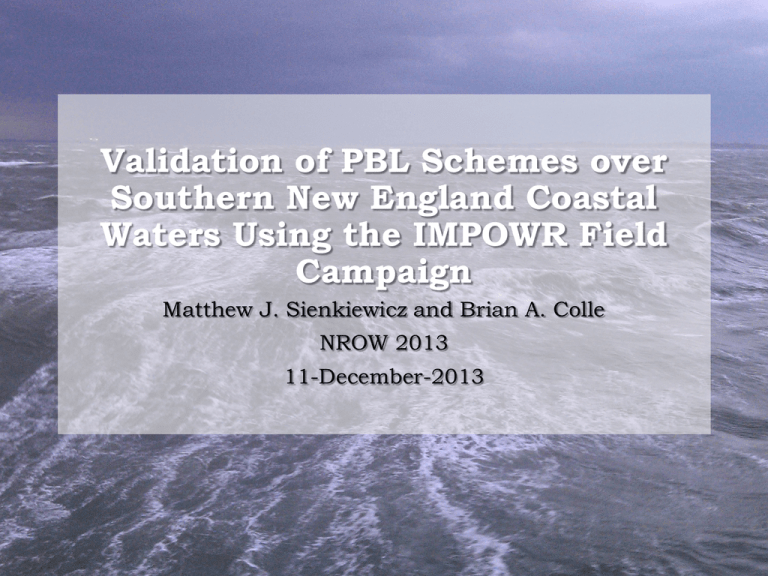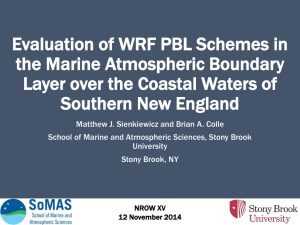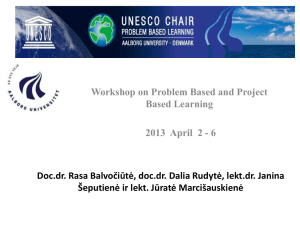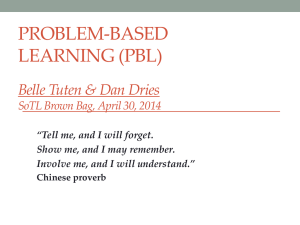Validation of Planetary Bound
advertisement

Validation of PBL Schemes over Southern New England Coastal Waters Using the IMPOWR Field Campaign Matthew J. Sienkiewicz and Brian A. Colle NROW 2013 11-December-2013 Outline Motivation (Offshore Wind Energy) PBL Schemes How do schemes perform in coastal waters? Historical Study Period Buoy/Tower verification IMPOWR Field Campaign Long-EZ Aircraft Flights Summary United States Offshore Wind Resource National Renewable Energy Laboratory, U.S. Department of Energy Bathymetry Wind Speed at 90 m Shallow coastal waters and high wind resource at hub height make Southern New England a prime location for offshore wind farms. Forecasting for Offshore Wind Farms Day-ahead / Hourahead power output forecasts NWP mesoscale models Uncertainty forecasts (ensembles) Neural Network corrections to obtain power output CFD models http://www.wind-power-program.com/turbine_characteristics.htm 𝑷𝒐𝒘𝒆𝒓~(𝒗𝒆𝒍𝒐𝒄𝒊𝒕𝒚)𝟑 Turbulence Closure Schemes Simplified Mean Equations 𝜕𝑢 𝜕𝑡 = −𝜌−1 𝜕𝑝 𝜕𝑥 + 𝑓𝑣 − 𝜕 𝑢′ 𝑤′ 𝜕𝑧 𝜕𝑣 𝜕𝑡 = −𝜌−1 𝜕𝑝 𝜕𝑦 − 𝑓 𝑢 − 𝜕 𝑣 ′ 𝑤′ 𝜕𝑧 𝜕𝜃𝑣 𝜕𝑡 = 𝜌𝑐𝑝 −1 𝜕𝑅𝑁 𝜕𝑧 − 𝜕 𝑤 ′ 𝜃𝑣 ′ 𝜕𝑧 𝜕 𝑞 𝜕𝑡 = − 𝜕 𝑤 ′ 𝑞′ 𝜕𝑧 Need to solve for unknown covariance terms First-order Closure 𝑢𝑗′ 𝑠 ′ = −𝐾𝑠 𝜕𝑠 𝜕𝑥𝑗 where 𝐾𝑠 is the eddy diffusivity of 𝑠. (Garratt 1992) TKE-order Closure 𝐾 = Λ𝑒 1 2 where 𝛬 is an empirical length scale, and 𝑒 is the TKE. Second-order Closure Covariance terms are solved for using their respective rate equations and approximations for the third moments Planetary Boundary Layer Schemes Most schemes developed and tested over land WRF PBL comparison studies mostly done over land Kansas – schemes overestimated heights of LLJs and underestimated wind speeds (Storm 2008) Kansas – large nocturnal wind speed biases, inaccurately simulated stable boundary layer (Shin and Hong 2011) Few WRF PBL comparison studies done over ocean Japan – positive wind speed bias in lower PBL (Shimada et al. 2011) North Sea – updating master length scale in MYJ scheme better represented wind shear in lower PBL (Suselj and Sood 2010) How do the WRF PBL schemes perform in the Southern New England coastal marine environment? Study divided into two distinct periods Historical Period 2003-2011 Set of 4km WRF runs verified using data from the Cape Wind Meteorological Mast, as well as available NDBC platforms. IMPOWR Field Campaign 2013 Joint campaign with University of Delaware to observe MBL with highfrequency tower and aircraft measurements during Spring/Summer 2013. Historical Study Period WRF-ARW (v3.4.1) CW tower data (2003-2011) Multi-level winds and temperatures 90 randomly and uniformly selected dates Cool season/warm season 00z/12z initialization times WRF DOMAINS Cape Wind Meteorological Mast 60 m Six PBL schemes First-Order YSU, ACM2 TKE-Order MYJ, MYNN2, BouLac, QNSE 30-hour simulations Focus is on operational hour-ahead wind forecasts 41 m 20 m NARR as boundary/initial conditions http://www.capewind.org Available Marine Observing Platforms 2003-2011 Only focusing on nearshore stations with solid data records http://www.ndbc.noaa.gov/maps/northeast_hist.shtml WRF results were bi-linearly interpolated to each station for verification. Observed winds were corrected from the buoy anemometer height of 5 meters to a standard height of 10 meters using 𝑢2 𝑢1 = 𝑧2 𝑃 where 𝑧1 𝑃 = 0.11. WSP BIASES – Northern Buoys (44013 and 44018) Weakly Positive Biases during Night Weaker to Negative during Day Stronger Positive Warm Season Biases Strongest at Night WSP BIASES – Southern Buoys (44017 and 44025) Smaller to more negative biases for both day and night compared to Northern Buoys Weaker Warm season biases than Northern Buoys Biases now stronger during Day WSP BIASES – CMAN Stations (ALSN6 and BUZM3) BouLac scheme shows consistent negative bias Negative Bias during Night TEMP BIASES – Northern Buoys (44013 and 44018) Weak warm biases Stronger warm biases TEMP BIASES – Southern Buoys (44017 and 44025) Stronger warm biases than Northern Buoys Weaker warm biases than Northern Buoys during night Weak cool biases during day TEMP BIASES – CMAN Stations (ALSN6 and BUZM3) Mostly negative biases during day Nighttime biases are variable between schemes Biases similar to Southern Buoys Cases with Model Spread? 24-January-2011 BouLac scheme (negative bias) Buoy/Tower Verification Conclusions Mostly positive wind speed biases at surface during Warm Season Weaker in South than North BouLac scheme shows consistent negative wind speed bias during Cool Season Stronger negative daytime biases in wind speed during Cool Season at Southern Buoys compared to Northern Buoys Negative daytime bias in wind speed just above surface during Warm Season More marine boundary layer observations are needed IMPOWR Field Campaign Improving the Mapping and Prediction of Offshore Wind Resources Began Spring 2013 Long-EZ Aircraft Flights Instrumented towers Sonic Anemometers Temperatures Humidities http://dendrite.somas.stonybrook.edu/IMPOWR/impowr.html Long-EZ AIRCRAFT 40 Hz Observations 3D Winds Temperature Pressure Humidity GPS and Inertial Systems Air-flow Probe AIMMS-20 NANTUCKET SOUND CAPE WIND TOWER Flight Day Weather Conditions 12 November 2012 Cyclone warm sector with south winds 4 April 2013 Southwest flow around anticyclone 7 April 2013 Stable strong south flow ahead of warm front 9 April 2013 Southwest flow ahead of cold front 4 May 2013 Moderate northeast flow with a subsidence inversion at top of PBL 10 May 2013 Southwest flow with coastal sea breezes 16 May 2013 Southwest flow with coastal jet 20 June 2013 Coastal sea breeze with westerly flow aloft 21 June 2013 Coastal sea breeze with westerly flow aloft 23 June 2013 Southwesterly flow with coastal enhancement 24 June 2013 NY Bight jet event 28 September 2013 Northeasterly flow around anticyclone 2 October 2013 Weak westerly flow 12-November-2012 Warm Sector of Cyclone Flight 12-Nov-2012 BUZM3 Obs vs. WRF 16-May-2013 Coastal Jet Flight 16-May-2013 Porpoise Maneuvers 1000-980 hPa WRF vs. Aircraft 1000-980 hPa Rapid Refresh Winds (kts) 1000 hPa 925 hPa Summary PBL errors over the coastal ocean vary by season, location, and time of day IMPOWR Field Campaign for MBL Aircraft Observations Tower Observations NEXT STEPS Run WRF for each flight case/PBL scheme Winds, temperatures, moisture Momentum Fluxes Sensible and Latent heat fluxes Turbulent Kinetic Energy IMPOWR Field Campaign will continue Spring/Summer 2014 References Bougeault, P., and P. Lacarrere, 1989: PARAMETERIZATION OF OROGRAPHY-INDUCED TURBULENCE IN A MESOBETA-SCALE MODEL. Monthly Weather Review, 117, 1872-1890. Dvorak, M. J., E. D. Stoutenburg, C. L. Archer, W. Kempton, and M. Z. Jacobson, 2012: Where is the ideal location for a US East Coast offshore grid? Geophys. Res. Lett., 39. Garratt, J. R., 1992: The Atmospheric Boundary Layer, Cambridge University Press, 316 pp. Hong, S. Y., Y. Noh, and J. Dudhia, 2006: A new vertical diffusion package with an explicit treatment of entrainment processes. Monthly Weather Review, 134, 2318-2341. Janjic, Z. I., 2001: Nonsingular implementation of the Mellor-Yamada level 2.5 scheme in the NCEP Meso model. Technical report, National Centers for Environmental Prediction: Camp Springs, MD, USA. Nakanishi, M., and H. Niino, 2006: An improved mellor-yamada level-3 model: Its numerical stability and application to a regional prediction of advection fog. Boundary-Layer Meteorology, 119, 397-407. Pleim, J. E., 2007: A combined local and nonlocal closure model for the atmospheric boundary layer. Part I: Model description and testing. J. Appl. Meteorol. Climatol., 46, 1383-1395. Shimada, S., T. Ohsawa, S. Chikaoka, and K. Kozai, 2011: Accuracy of the Wind Speed Profile in the Lower PBL as Simulated by the WRF Model. Sola, 7, 109-112. Shin, H. H., and S. Y. Hong, 2011: Intercomparison of Planetary Boundary-Layer Parametrizations in the WRF Model for a Single Day from CASES-99. Boundary-Layer Meteorology, 139, 261-281. Sukoriansky, S., B. Galperin, and V. Perov, 2006: A quasi-normal scale elimination model of turbulence and its application to stably stratified flows. Nonlinear Process Geophys., 13, 9-22. Suselj, K., and A. Sood, 2010: Improving the Mellor-Yamada-Janjic Parameterization for wind conditions in the marine planetary boundary layer. Boundary-Layer Meteorology, 136, 301-324. Calculation of Turbulent Quantities Turbulent Kinetic Energy 𝑒 = 𝑢′2 + 𝑣′2 + 𝑤′2 Vertical Momentum Fluxes 2 Sensible and Latent Heat Fluxes 𝐻𝑣 = 𝜌𝑐𝑝 𝑤′𝜃𝑣 ′ 𝐸 = 𝜌𝐿𝑣 𝑤′𝑞′. 𝜏𝑥 = −𝜌𝑢′𝑤′ 𝜏𝑦 = −𝜌𝑣′𝑤′ Full TKE Budget Equation ′𝑒′ ′ 𝑝′ 𝑑𝑒 𝑔 𝜕𝑢 𝜕𝑣 𝜕 𝑤 1 𝜕 𝑤 = 𝑤 ′ 𝜃𝑣 ′ − 𝑢′ 𝑤 ′ + 𝑣 ′𝑤 ′ − − − 𝜀. 𝑑𝑡 𝜃𝑣 𝜕𝑧 𝜕𝑧 𝜕𝑧 𝜌 𝜕𝑧 (Garratt 1992)











